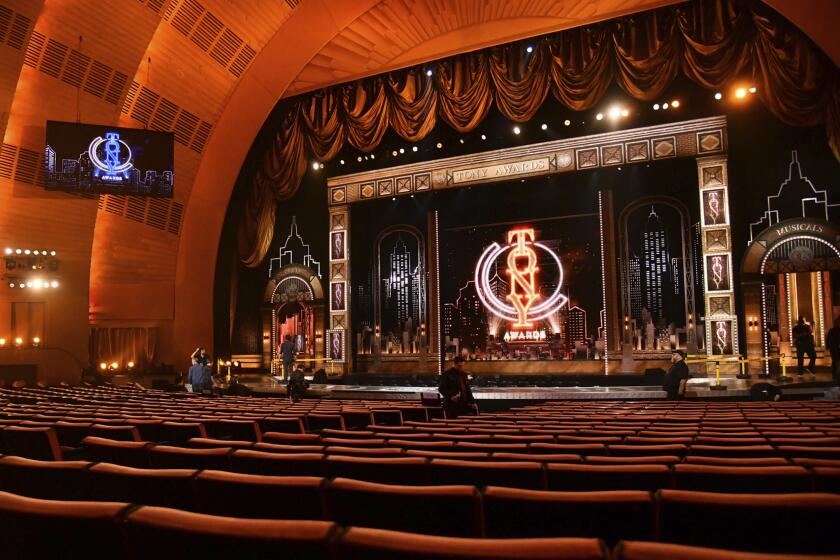Two Masters, One Vision
- Share via
If the Los Angeles Philharmonic’s ongoing “Schoenberg Prism” has not generated the kind of excitement that its Stravinsky Festival did last season, it may be a matter of emphasis. Stravinsky was celebrated as a composer who shaped the future, namely our own times. Schoenberg, on the other hand, is being viewed as a composer whose influence we fear. Along with an emphasis on his early, less “threatening” works, the season has paired Schoenberg with Beethoven and Mozart early on; in upcoming concerts he holds hands with his contemporaries Gershwin and Mahler. One Green Umbrella program looks at Schoenberg’s legacy but will have no Schoenberg on it.
Friday afternoon, the Philharmonic, fresh for the new year, played Schoenberg’s “Pelleas and Melisande” and Brahms’ First Piano Concerto. Both are immediately accessible, well-known works written by composers in their mid-20s. At that enthusiastic age, Schoenberg was, in the words of the Philharmonic brochure, “unabashedly romantic.” So, too, was Brahms. But Esa-Pekka Salonen and the French pianist Helene Grimaud demonstrated that there is more to it than that.
We may perceive Brahms as the quintessential Romantic composer and Schoenberg as the progressive. Yet in a famous 1947 essay, Schoenberg proclaimed Brahms a progressive. And both composers thought themselves essentially as preserving the Classical tradition of Haydn, Mozart and Beethoven.
In fact, what makes Brahms and Schoenberg continually interesting is the continual play of Classicism, Romanticism and Modernism in their music.
For the turn-of-the-century tone poem “Pelleas and Melisande,” Schoenberg took as his subject a symbolist French play that allowed him to dig deep into the psyches of lovers. Schoenberg the Romantic dramatized the narrative; Schoenberg the Classicist structured it in the formal mold of a symphony; Schoenberg the Modernist evoked extreme emotional states with extreme harmonies and a complex intermingling of themes.
At one point, Pelleas and his brother Golaud enter a cave, as dark and scary as the deepest recesses of their inner selves, and Schoenberg invents otherworldly new sounds in the orchestra. As the musicologist Robert Fink strikingly pointed out on a preconcert panel, this could not be a more apt metaphor for our times. We continue to contemplate the horror of an infamous large hole in the ground, to say nothing of the terror that lurks in caves, and Schoenberg captures that atmosphere perfectly.
*
“Pelleas” is a difficult piece to get right. A critic wrote of the first performance that the composer should be locked away in an asylum and music paper kept of his reach. But one can only imagine what the performance, which Schoenberg himself conducted, may have sounded like under an inexperienced leader and probably hostile orchestra. This is music that requires an expert ability to achieve textural clarity from a very thick orchestration (Schoenberg was still a relatively inexperienced orchestrator as well), along with a sense of dramatic propulsion.
In a superb performance, Salonen solved those problems better than I have ever heard before. From the very start, he captured the vivid turbulence of Schoenberg’s gripping sound world. The orchestra’s playing was rich and alluring. Solo lines from bass clarinet (David Howard), violin (Martin Chalifour) and viola (Evan Wilson) had personality. A drama came to life. But so did an intricate, intriguing musical structure.
Brahms’ concerto shares many characteristics with “Pelleas”--the same key of D, the same generous scale (about 45 minutes) and a similar symphonic grandeur. And Salonen conducted it on the second half of the program, not as if he were discarding Schoenberg’s 20th century for Brahms’ 19th, but as if were empowered by the knowledge that this is music that would lead to somewhere, as Brahms the progressive. Again, there was bold drama, especially in the rhythmic energy and the clarity of the orchestral playing.
There was similar clarity and rhythmic propulsion in Grimaud’s solos, if less weight. She is a lively player who makes the piano’s keys all seem to be springs, and her tone has the quality of polished steel.
The nuances of her phrasing give the impression of being slightly contrived, and that made her dull in the slow movement. But in fast passages, when she had less time to fuss, when Salonen’s dynamism required from her instinctive response, she was impressive and old Brahms sounded newly minted.
More to Read
The biggest entertainment stories
Get our big stories about Hollywood, film, television, music, arts, culture and more right in your inbox as soon as they publish.
You may occasionally receive promotional content from the Los Angeles Times.











